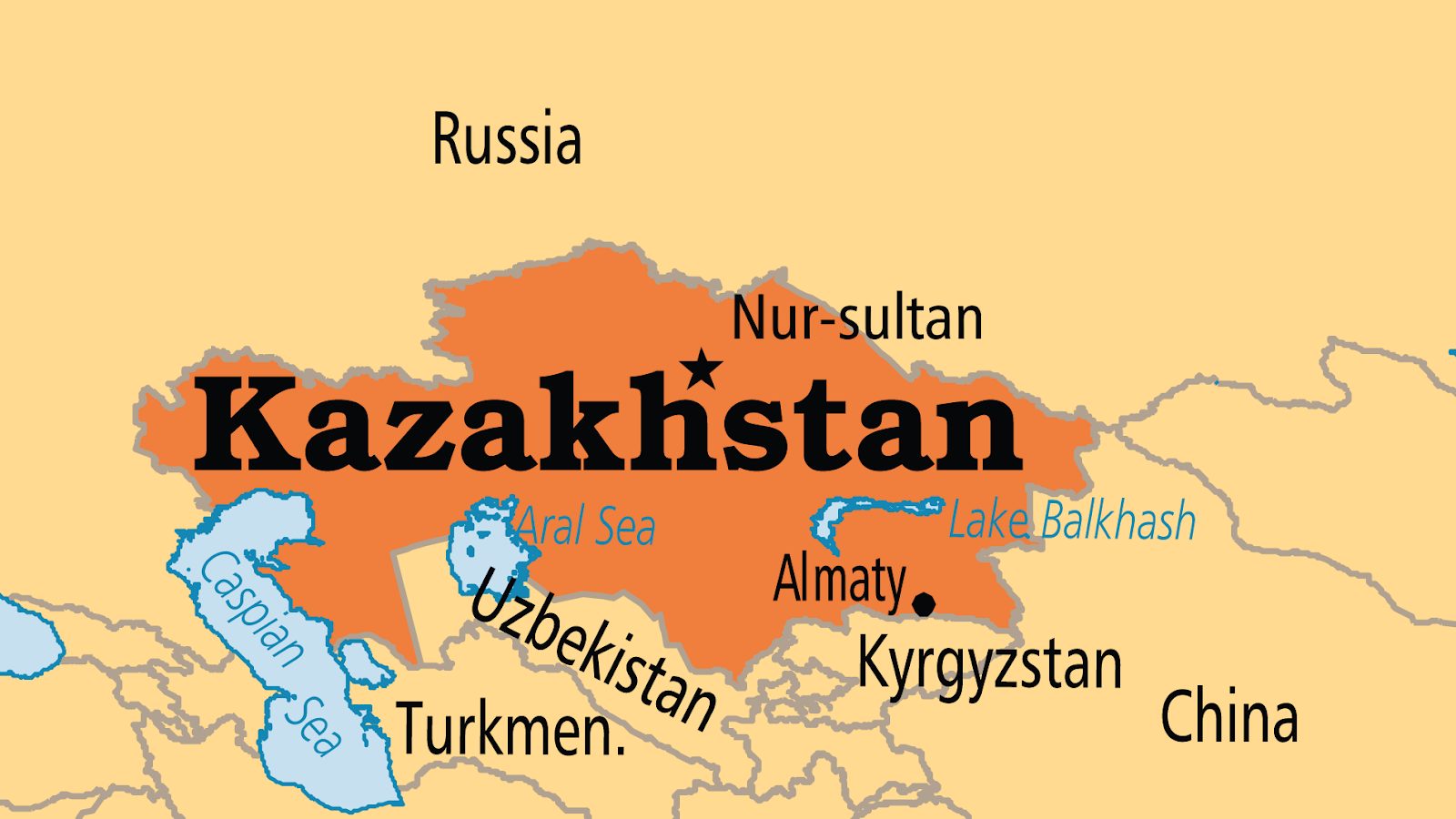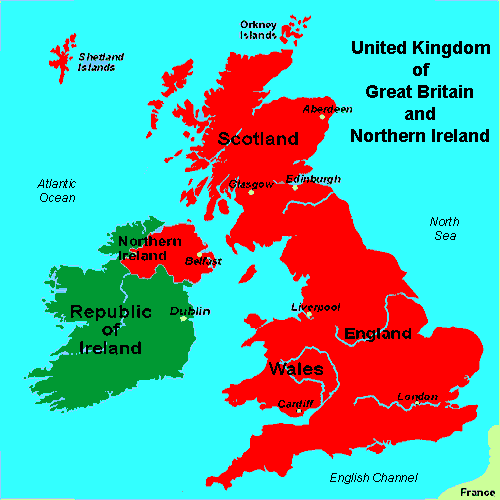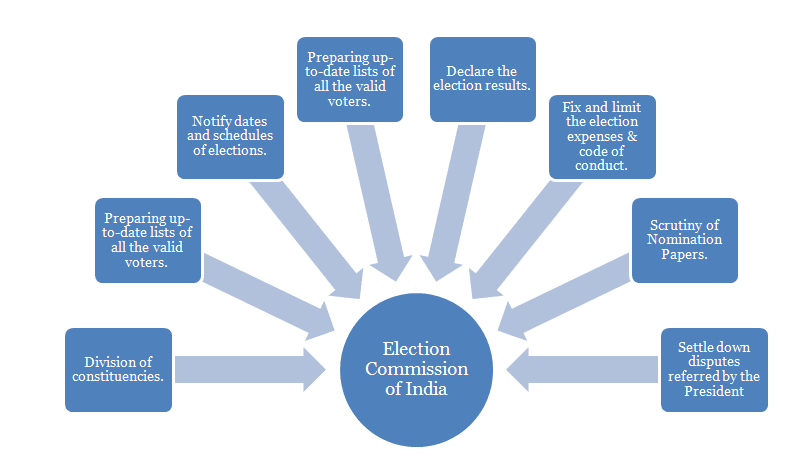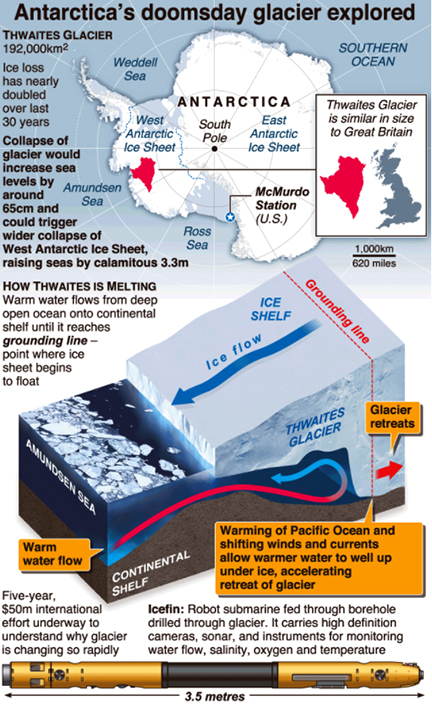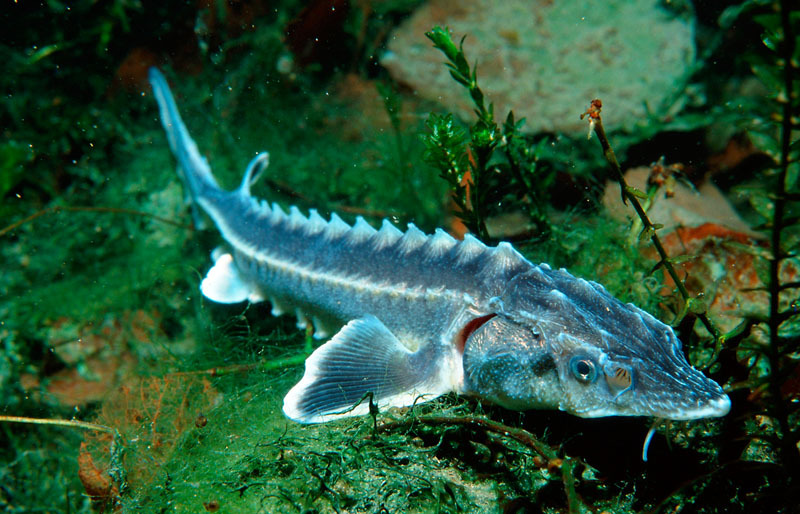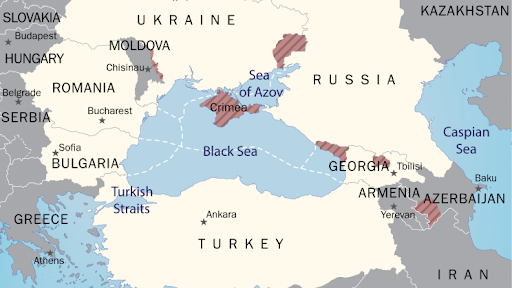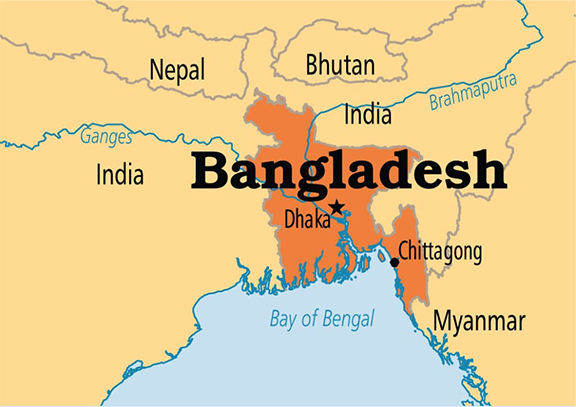International Relations
Visit of Defence Minister of Kazakhstan
Why in News
Recently, the Defence Minister of India held bilateral talks with the Defence Minister of the Republic of Kazakhstan in New Delhi.
- The two Ministers had last met in Moscow (Russia) in September 2020 on the sidelines of Shanghai Cooperation Organisation (SCO) Defence Ministers’ meeting.
Key Points
- Highlights of the Talks:
- Agreed that both sides must look at the possibility of defence industrial collaboration of mutual interest.
- Exchanged views to further strengthen bilateral defence cooperation, including through training, defence exercises and capacity building.
- Kazakhstan thanked India for the opportunity given to the Kazakh troops for deployment as part of the Indian battalion in the United Nations Interim Force in Lebanon (UNIFIL).
- UNIFIL was established by the UN Security Council in 1978 to confirm Israeli withdrawal from Lebanon, restore international peace and security and assist the Lebanese Government in restoring its effective authority in the area.
- Assessed the annual joint military exercise KAZIND.
- Indo-Kazakh Defence Cooperation:
- It is carried out under the framework of an agreement on ‘Defence and Military Technical Cooperation’ signed in July 2015 during the visit of Indian Prime Minister to Kazakhstan.
- The agreement includes conduct of joint training, exercises, military-technical cooperation, UN peacekeeping and exchange of intelligence.
- Kazakh Armed Forces Unit underwent training on peacekeeping operations in India in April-May 2018 for deployment under the command of an Indian Battalion at UNIFIL, Lebanon.
- Significance of Kazakhstan to India:
- There are three factors which make Kazakhstan important for India. First, its geo-strategic location; second, its economic potential, especially in terms of energy resources; and third, its multi-ethnic and secular structure.
- Kazakhstan’s geo-political existence between Russia and Asia, along with long borders with China, makes it a country of great strategic importance.
- Kazakhstan lies to the northeast of the Caspian Sea, bordered by the Russian Federation to the north, China to the east, and Kyrgyzstan, Turkmenistan and Uzbekistan to the south.
- Kazakhstan can also help India achieve a geostrategic rebalancing with China. India’s foremost objective is countering the rapid economic inroads China is making in the region through the One Belt One Road (OBOR) initiative.
- India seeks to achieve this with the competing North-South Transport Corridor (NSTC).
- NSTC is a multi-modal transportation established on 12th September 2000 in St. Petersburg, by Iran, Russia and India for the purpose of promoting transportation cooperation among the Member States. It has been expanded to include eleven new members.
- Kazakhstan has become one of the key activists in the field of global nuclear security, and has achieved a number of results in peacekeeping policies and the resolution of conflicts around Nagorno-Karabakh, Iran, Ukraine and Syria.
India - Kazakhstan Relations
- Historical:
- Relations between India and Kazakhstan are ancient and historical going back to more than 2000 years.
- There has been a constant and regular flow of trade in goods and, more importantly, exchange of ideas and cultural influences.
- The flow of Buddhism from India to Central Asia and Sufi ideas from Central Asia to India are two such examples.
- Political Relations:
- India was one of the first countries to recognize the independence of Kazakhstan. Diplomatic relations were established in February 1992.
- India and Kazakhstan have been strategic partners since 2009.
- Cooperation at Multilateral Fora:
- India and Kazakhstan actively cooperate under the aegis of Multilateral Fora including CICA, SCO and the UN organizations.
- India has been a consistent supporter of Kazakhstan’s initiative on Conference on Interaction and Confidence-Building Measures in Asia (CICA) and is actively participating in the process.
- Kazakhstan supports India’s permanent membership in an expanded United Nations Security Council (UNSC) and has extended its support for India's non-permanent membership in 2021-22.
- Trade and Economy:
- The India-Kazakhstan Inter-Governmental Commission (IGC) established in 1993 is the apex bilateral institutional mechanism for developing trade, economic, scientific, technological, industrial and cultural cooperation between the two countries.
- The Ministry of Petroleum and Natural Gas on the Indian side and Ministry of Energy on the Kazakh side are the nodal ministries with respective Ministers as the Co-Chair of the Commission.
- Several Joint Working Groups (JWGs) have been established in the areas of Counter Terrorism, Trade & Economic Cooperation, Defence & Military Technical Cooperation, Information Technology, Hydrocarbons, Textiles, Tea Debt and Space Cooperation, Health and Transport, Connectivity & Logistics to take forward bilateral relations in the respective spheres.
- Kazakhstan is India’s largest trade and investment partner in Central Asia.
- The India-Kazakhstan Inter-Governmental Commission (IGC) established in 1993 is the apex bilateral institutional mechanism for developing trade, economic, scientific, technological, industrial and cultural cooperation between the two countries.
- Space Cooperation:
- Indian Space Research Organization (ISRO) launched “Al-Farabi-1”, a 1.7 kg Technology Demonstrator Nano Satellite built by Al-Farabi Kazakh National University, Almaty along with 103 other satellites in 2017.
- A delegation from ISRO attended Kazakh Defence Expo ‘KADEX’ in May 2018.
- Civil Nuclear Cooperation:
- Kazakhstan supported India in obtaining India-specific exemption to allow civil nuclear cooperation with Nuclear Suppliers Group (NSG) countries in 2008.
- Indian Technical and Economic Cooperation (ITEC):
- India provides capacity building assistance to Kazakhstan in various specialized fields under ITEC program sponsored by the Ministry of External Affairs.
- Consular:
- India and Kazakhstan have an agreement on visa free entry for Diplomatic and Official Passport holders.
- Since February 2018, Indian has extended e-visa facility to Kazakh citizens.
- Kazakhstan has also introduced electronic visa facilities for travelers from India with effect from 1st January 2019.
Way Forward
- Being part of central Asia, Kazakhstan is strategically important for India. India needs to use its instrument of economic leverages more efficiently to build closer ties with Central Asia.
- At its core, the heightened India-Kazakhstan relationship allows New Delhi to bypass Pakistan and the highly unstable Afghanistan to reach a resource-rich Nur-Sultan, complementing India’s developing economy.
International Relations
Violence in Northern Ireland (UK)
Why in News
Recently, Northern Ireland, the United Kingdom (UK) saw the worst violence in years. Parts of Northern Ireland are split along sectarian lines, 23 years after a peace deal largely ended Northern Ireland's troubles.
Key Points
- Historical Conflict:
- Geographically, Northern Ireland is part of Ireland. Politically, it’s part of the UK.
- Ireland, long dominated by the UK, broke free about 100 years ago after centuries of colonisation and an uneasy union. 26 of its 32 counties became an independent, Roman Catholic-majority country. 6 counties in the north, which have a Protestant majority, stayed British.
- Northern Ireland’s Catholic minority experienced discrimination in the Protestant-run state.
- In the 1960s, a Catholic civil rights movement demanded change, but faced a harsh response from the government and police.
- The British Army was deployed in 1969, initially to keep the peace.
- The situation deteriorated into a conflict between Irish republican militants who wanted to unite with the south, loyalist paramilitaries who sought to keep Northern Ireland British, and UK troops.
- During three decades of conflict, more than 3,600 people, a majority of them civilians, were killed in bombings and shootings. Most were in Northern Ireland, though the Irish Republican Army also set off bombs in London and other British cities.
- Ending the Conflict:
- By the 1990s, after secret talks and with the help of diplomatic efforts by Ireland, Britain and the United States, the combatants reached a peace deal.
- The 1998 Good Friday accord saw the paramilitaries lay down their arms and established a Catholic-Protestant power-sharing government for Northern Ireland.
- The question of Northern Ireland’s ultimate status was deferred: it would remain British as long as that was the majority’s wish, but a future referendum on reunification was not ruled out.
- While the peace has largely endured, small Irish Republican Army splinter groups have mounted occasional attacks on security forces, and there have been outbreaks of sectarian street violence.
- The power-sharing arrangement has had periods of success and failure and still the government is not trusted by both the sides.
- Problem Child of Brexit:
- Northern Ireland has been called the “problem child” of Brexit, the UK’s divorce from the European Union (EU).
- As the only part of the UK that has a border with an EU nation, Ireland, it was the trickiest issue to resolve after Britain voted narrowly in 2016 to leave the 27-nation bloc.
- An open Irish border, over which people and goods flow freely, underpins the peace process, allowing people in Northern Ireland to feel at home in both Ireland and the UK.
- The insistence of Britain’s government on a “hard Brexit” that took the country out of the EU’s economic order meant the creation of new barriers and checks on trade.
- Both Britain and the EU agreed that the border could not be in Ireland because of the risk that would pose to the peace process. The alternative was to put it, metaphorically, in the Irish Sea between Northern Ireland and the rest of the UK.
- That arrangement has alarmed British unionists, who say it weakens Northern Ireland’s place in the UK and could bolster calls for Irish reunification.
- Reason for Current Violence:
- Brexit and Corona:
- Britain left the EU on 31st December and the new trade arrangements quickly became an irritant to Northern Ireland unionists who want to stay in the UK.
- Early trade glitches, exacerbated by the coronavirus pandemic, led to some empty supermarket shelves, fueling alarm.
- There was anger that British Prime Minister long insisted there would be no new checks on trade as a result of Brexit, had downplayed the scale of the changes wrought by leaving the EU.
- Identity Crisis:
- Some in Northern Ireland’s British loyalist community feel as if their identity is under threat. And many other loyalists believe that, de facto, Northern Ireland has ceased to be as much a part of the UK as it was.
- Brexit and Corona:
Indian Polity
Chief Election Commissioner
Why in News
Recently, the President appointed Election Commissioner Sushil Chandra as the Chief Election Commissioner (CEC).
- He replaces Sunil Arora who has retired.
Key Points
- About the Election Commission of India:
- The Election Commission of India (ECI) is an autonomous constitutional authority responsible for administering Union and State election processes in India.
- It was established in accordance with the Constitution on 25th January 1950 (celebrated as national voters' day). The secretariat of the commission is located in New Delhi.
- The body administers elections to the Lok Sabha, Rajya Sabha, and State Legislative Assemblies in India, and the offices of the President and Vice President in the country.
- It is not concerned with the elections to panchayats and municipalities in the states. For this, the Constitution of India provides for a separate State Election Commission.
- The Election Commission of India (ECI) is an autonomous constitutional authority responsible for administering Union and State election processes in India.
- Constitutional Provisions:
- Part XV (Article 324-329) of the Indian Constitution: It deals with elections, and establishes a commission for these matters.
- Article 324: Superintendence, direction and control of elections to be vested in an Election Commission.
- Article 325: No person to be ineligible for inclusion in, or to claim to be included in a special, electoral roll on grounds of religion, race, caste or sex.
- Article 326: Elections to the House of the People and to the Legislative Assemblies of States to be on the basis of adult suffrage.
- Article 327: Power of Parliament to make provision with respect to elections to Legislatures.
- Article 328: Power of Legislature of a State to make provision with respect to elections to such Legislature.
- Article 329: Bar to interference by courts in electoral matters.
- Structure of ECI:
- Originally the commission had only one election commissioner but after the Election Commissioner Amendment Act 1989, it has been made a multi-member body
- The Election Commission shall consist of the Chief Election Commissioner (CEC) and such number of other election commissioners, if any, as the President may from time to time fix.
- Presently, it consists of the CEC and two Election Commissioners.
- At the state level, the election commission is helped by the Chief Electoral Officer who is an IAS rank Officer.
- Appointment & Tenure of Commissioners:
- The President appoints CEC and Election Commissioners.
- They have a fixed tenure of six years, or up to the age of 65 years, whichever is earlier.
- They enjoy the same status and receive salary and perks as available to Judges of the Supreme Court (SC) of India.
- Removal:
- They can resign anytime or can also be removed before the expiry of their term.
- The CEC can be removed from office only through a process of removal similar to that of a SC judge by Parliament.
Procedure of Removal
- Judges of High Courts and SC, CEC, Comptroller and Auditor General (CAG) may be removed from office through a motion adopted by Parliament on grounds of ‘proved misbehaviour or incapacity’.
- Removal requires a special majority of 2/3rd members present and voting supported by more than 50% of the total strength of the house.
- The Constitution does not use the word ‘impeachment’, for the removal of the judges, CAG, CEC.
- The term ‘Impeachment’ is only used for removing the President which requires the special majority of 2/3rd members of the total strength of both the houses which is not used elsewhere.
- Limitations:
- The Constitution has not prescribed the qualifications (legal, educational, administrative or judicial) of the members of the Election Commission.
- The Constitution has not specified the term of the members of the Election Commission.
- The Constitution has not debarred the retiring election commissioners from any further appointment by the government.
- Powers and Functions of ECI:
- Administrative:
- To determine the territorial areas of the electoral constituencies throughout the country on the basis of the Delimitation Commission Act of Parliament.
- To prepare and periodically revise electoral rolls and to register all eligible voters.
- To grant recognition to political parties and allot election symbols to them.
- Election Commission ensures a level playing field for the political parties in election fray, through strict observance by them of a Model Code of Conduct evolved with the consensus of political parties.
- Advisory Jurisdiction & Quasi-Judicial Functions:
- Under the Constitution, the Commission has advisory jurisdiction in the matter of post election disqualification of sitting members of Parliament and State Legislatures.
- The opinion of the Commission in all such matters is binding on the President or, as the case may be, the Governor to whom such opinion is tendered.
- Further, the cases of persons found guilty of corrupt practices at elections which come before the SC and High Courts are also referred to the Commission for its opinion on the question as to whether such person shall be disqualified and, if so, for what period.
- The Commission has the power to disqualify a candidate who has failed to lodge an account of his election expenses within the time and in the manner prescribed by law.
- Under the Constitution, the Commission has advisory jurisdiction in the matter of post election disqualification of sitting members of Parliament and State Legislatures.
- Administrative:
Science & Technology
National Supercomputing Mission
Why in News
The second phase of the National Supercomputing Mission (NSM) will be completed by September 2021, taking India’s total computational capacity to 16 Petaflops.
Key Points
- About the National Supercomputing Mission (NSM):
- Launch: NSM was announced in 2015, with an aim to connect national academic and R&D institutions with a grid of more than 70 high-performance computing facilities at an estimated cost of Rs. 4,500 crores over the period of seven years by 2022.
- It supports the government's vision of 'Digital India' and 'Make in India'.
- Implementation: NSM is jointly steered by the Ministry of Electronics and IT (MeitY) and Department of Science and Technology (DST - Ministry of Science and Technology) and implemented by the Centre for Development of Advanced Computing (C-DAC), Pune and the Indian Institute of Science (IISc), Bengaluru.
- Features:
- It is also an effort to improve the number of supercomputers owned by India.
- These supercomputers will also be networked on the National Supercomputing grid over the National Knowledge Network (NKN). The NKN connects academic institutions and R&D labs over a high-speed network.
- Under NSM, the long-term plan is to build a strong base of 20,000 skilled persons over the next five years who will be equipped to handle the complexities of supercomputers.
- Launch: NSM was announced in 2015, with an aim to connect national academic and R&D institutions with a grid of more than 70 high-performance computing facilities at an estimated cost of Rs. 4,500 crores over the period of seven years by 2022.
- Progress of NSM:
- In the first phase, PARAM Shivay, PARAM Shakti, PARAM Brahma, PARAM Yukti and PARAM Sanganak were deployed at IIT (BHU), IIT Kharagpur, Indian Institute of Science Education and Research, Pune, and Jawaharlal Nehru Centre for Advanced Research.
- Recently, PARAM-Siddhi AI, has been ranked 63rd in the Top 500 list of most powerful supercomputers in the world. It was developed under the NSM.
- Recent Development:
- In October 2020, C-DAC had inked MoUs with IITs along with IISc, National Agri-Food Biotechnology Institute and NIT, Tiruchirapalli — where a High Power Computing (HPC) system in each institute is currently being installed.
- So far, over 4,500 people have been trained in HPC and further training in Artificial Intelligence will be held at special NSM nodal centres established at four IITs — Kharagpur, Madras, Goa and Palakkad.
- Challenges:
- The NSM envisages setting up a network of 70 high-performance computing facilities in the country but skewed funding for the mission during the initial years slowed down the overall pace of building supercomputers.
- Only 16.67% of the total budget of Rs. 4,500 crore, was utilised during the first four-and-a-half years for execution of the mission.
- Global Scenario:
- Globally, China has the maximum number of supercomputers and maintains the top position in the world, followed by the US, Japan, France, Germany, Netherlands, Ireland and the United Kingdom.
Geography
Antarctica’s Doomsday Glacier
Why in News
Researchers from Sweden’s University of Gothenburg have been able to obtain data from underneath Thwaites Glacier, also known as the 'Doomsday Glacier'.
- They find that the supply of warm water to the glacier is larger than previously thought, triggering concerns of faster melting and accelerating ice flow.
Key Points
- Doomsday Glacier:
- Called the Thwaites Glacier, it is 120 km wide at its broadest, fast-moving, and melting fast over the years.
- Because of its size (1.9 lakh square km), it contains enough water to raise the world sea level by more than half a metre.
- Studies have found the amount of ice flowing out of it has nearly doubled over the past 30 years.
- Today, Thwaites’s melting already contributes 4% to global sea level rise each year.
- It is estimated that it would collapse into the sea in 200-900 years.
- Thwaites is important for Antarctica as it slows the ice behind it from freely flowing into the ocean.
- Because of the risk it faces, and poses, Thwaites is often called the Doomsday Glacier (Doomsday meaning warning or threat, something that can cause destruction).
- Previous Studies:
- Hole in the Glacier: A 2019 study had discovered a fast-growing cavity in the glacier, sized roughly two-thirds the area of Manhattan.
- The size of a cavity under a glacier plays an important role in melting. As more heat and water get under the glacier, it melts faster.
- Detection of Warm Water at Grounding Line:
- About: In 2020, researchers from New York University (NYU) detected warm water at a vital point below the glacier. In the NYU study, scientists dug a 600-m-deep and 35-cm-wide access hole, and deployed an ocean-sensing device called Icefin to measure the waters moving below the glacier’s surface.
- Findings:
- The NYU study reported water at just two degrees above freezing point at Thwaites’s “grounding zone” or “grounding line”.
- The grounding line is the place below a glacier at which the ice transitions between resting fully on bedrock and floating on the ocean as an ice shelf. The location of the line is a pointer to the rate of retreat of a glacier.
- When glaciers melt and lose weight, they float off the land where they used to be situated. When this happens, the grounding line retreats. That exposes more of a glacier’s underside to seawater, increasing the likelihood it will melt faster.
- This results in the glacier speeding up, stretching out, and thinning, causing the grounding line to retreat ever further.
- Hole in the Glacier: A 2019 study had discovered a fast-growing cavity in the glacier, sized roughly two-thirds the area of Manhattan.
- Findings from Sweden’s Gothenburg Study (New Study):
- About: Sweden’s Gothenburg study used an uncrewed submarine to go under the Thwaites glacier front to make observations.
- The submersible called “Ran” measured among other things the strength, temperature, salinity and oxygen content of the ocean currents that go under the glacier.
- Using the results, the researchers have been able to map the ocean currents that flow below Thwaites’s floating part.
- Findings: The researchers have been able to identify three inflows of warm water, among whom the damaging effects of one had been underestimated in the past.
- The researchers discovered that there is a deep connection to the east through which deep water flows from Pine Island Bay, a connection that was previously thought to be blocked by an underwater ridge.
- Pine Island Bay is a drainage system of West Antarctica.
- The study also looked at heat transport in one of the three channels which brings warm water towards the glacier from the north.
- They found that there were distinct paths that water takes in and out of the ice shelf cavity, influenced by the geometry of the ocean floor.
- The researchers discovered that there is a deep connection to the east through which deep water flows from Pine Island Bay, a connection that was previously thought to be blocked by an underwater ridge.
- About: Sweden’s Gothenburg study used an uncrewed submarine to go under the Thwaites glacier front to make observations.
Way Forward
- The study shows that warm water is approaching the pinning points of the glacier from all sides, impacting these locations where the ice is connected to the seabed and where the ice sheet finds stability. This has the potential to make things worse for Thwaites, whose ice shelf is already retreating.
- For the first time, data is being collected that is necessary to model the dynamics of Thwaites glacier. This data will help better calculate ice melting in the future.
- With the help of new technology, models can be improved and the great uncertainty that now prevails around global sea level variations can be reduced.
Biodiversity & Environment
Danube Sturgeon
Why in News
According to a report released by the World Wildlife Fund (WWF), illegal sale of Danube Sturgeon, one of the most endangered species in the world, is rampant in the lower Danube (River) region, especially in Bulgaria, Romania, Serbia and Ukraine.
- Danube is the second longest river in Europe after the Volga. It rises in the Black Forest mountains of western Germany and flows for some 2,850 km to its mouth on the Black Sea.
Key Points
- About:
- Sturgeons have existed since the time of dinosaurs, for about 200 million years. Some of the species can grow up to eight metre in length and live more than a century.
- They are called ‘living fossils’ because their appearance has altered very little over the years.
- Living Fossil is an organism that has remained unchanged from earlier geologic times and whose close relatives are usually extinct.
- Other than Sturgeons, Horseshoe crab and ginkgo trees are examples of living fossils.
- Because the sturgeons live for so many years, mature late and spawn with long intervals, they take a long time to recover from environmental and human pressures, according to WWF. This makes them great indicators for the health of the river and other ecological parameters.
- Habitat:
- There are 27 species of sturgeons and paddlefishes distributed across the Northern hemisphere. While some species inhabit only freshwater, most species are anadromous, spawning in freshwater but spending much of their life history in marine or brackish environments.
- Danube sturgeons live mostly in the Black Sea, migrating up the Danube and other major rivers to spawn.
- Threats:
- Over-exploitation and poaching (exacerbated by poor fishery management and insufficient legal enforcement of fishing bans).
- Blocked migration routes through dams.
- Loss or degradation of habitats.
- Pollution.
- Protection Status:
- IUCN Red list: There are 6 species of sturgeon in the Danube River. Five of them are now listed as critically endangered.
- CITES: Appendix-II.
World Wildlife Fund for Nature
- About:
- It is the world’s leading conservation organization and works in more than 100 countries.
- Establishment:
- It was established in 1961 and is headquartered at Gland, Switzerland.
- Mission:
- To conserve nature and reduce the most pressing threats to the diversity of life on Earth.
- Important Initiatives of WWF:
Black Sea
- About:
- Black Sea is an inland sea located between far-southeastern Europe and the far-western edges of the continent of Asia and the country of Turkey.
- It connects to the Mediterranean Sea first through the Bosporus Strait, then through the Sea of Marmara and the Dardanelles Strait, then south through the Aegean Sea and the Sea of Crete.
- The Black Sea is also connected to the Sea of Azov by the Strait of Kerch.
- Bordering Countries:
- Romania, Bulgaria, Ukraine, Russia, Georgia, and Turkey.
Important Facts For Prelims
Exercise Shantir Ogroshena
Why in News
Multinational military exercise Shantir Ogroshena, which went for 10 days in Bangladesh, concluded on 12th April 2021.
- The year 2021 marks the 50th anniversary of diplomatic relations between India and Bangladesh.
Key Points
- About the Exercise:
- The exercise was organised to commemorate the birth centenary of Bangabandhu Sheikh Mujibur Rahman, Bangladesh’s Father of the Nation and celebrate the golden jubilee of the liberation of Bangladesh.
- It was held at Bangabandhu Senanibas (BBS), Bangladesh.
- ‘Shantir Ogroshena’ 2021 means “Front Runner of the Peace”.
- Theme:
- The theme of this exercise was to strengthen defence ties and enhance interoperability amongst neighbourhood countries to ensure effective peacekeeping operations.
- It was a UN (United Nations)- mandated counterterrorism exercise.
- Countries that Participated:
- Troops from India, Bangladesh, Bhutan and Sri Lanka participated in the exercise with observers from the USA, UK, Russia, Turkey, Saudi Arabia, Kuwait and Singapore.
- Other Exercises involving Bangladesh:
- SAMPRITI (Army).
- TABLE TOP (Air).
- IN-BN CORPAT (Navy).
- SAMVEDNA (Multinational Air Exercise with Bangladesh, Nepal, Sri Lanka and UAE).

